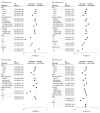Relative Burden of Cancer and Noncancer Mortality Among Long-Term Survivors of Breast, Prostate, and Colorectal Cancer in the US
- PMID: 37436746
- PMCID: PMC10339147
- DOI: 10.1001/jamanetworkopen.2023.23115
Relative Burden of Cancer and Noncancer Mortality Among Long-Term Survivors of Breast, Prostate, and Colorectal Cancer in the US
Abstract
Importance: Improvements in cancer outcomes have led to a need to better understand long-term oncologic and nononcologic outcomes and quantify cancer-specific vs noncancer-specific mortality risks among long-term survivors.
Objective: To assess absolute and relative cancer-specific vs noncancer-specific mortality rates among long-term survivors of cancer, as well as associated risk factors.
Design, setting, and participants: This cohort study included 627 702 patients in the Surveillance, Epidemiology, and End Results cancer registry with breast, prostate, or colorectal cancer who received a diagnosis between January 1, 2003, and December 31, 2014, who received definitive treatment for localized disease and who were alive 5 years after their initial diagnosis (ie, long-term survivors of cancer). Statistical analysis was conducted from November 2022 to January 2023.
Main outcomes and measures: Survival time ratios (TRs) were calculated using accelerated failure time models, and the primary outcome of interest examined was death from index cancer vs alternative (nonindex cancer) mortality across breast, prostate, colon, and rectal cancer cohorts. Secondary outcomes included subgroup mortality in cancer-specific risk groups, categorized based on prognostic factors, and proportion of deaths due to cancer-specific vs noncancer-specific causes. Independent variables included age, sex, race and ethnicity, income, residence, stage, grade, estrogen receptor status, progesterone receptor status, prostate-specific antigen level, and Gleason score. Follow-up ended in 2019.
Results: The study included 627 702 patients (mean [SD] age, 61.1 [12.3] years; 434 848 women [69.3%]): 364 230 with breast cancer, 118 839 with prostate cancer, and 144 633 with colorectal cancer who survived 5 years or more from an initial diagnosis of early-stage cancer. Factors associated with shorter median cancer-specific survival included stage III disease for breast cancer (TR, 0.54; 95% CI, 0.53-0.55) and colorectal cancer (colon: TR, 0.60; 95% CI, 0.58-0.62; rectal: TR, 0.71; 95% CI, 0.69-0.74), as well as a Gleason score of 8 or higher for prostate cancer (TR, 0.61; 95% CI, 0.58-0.63). For all cancer cohorts, patients at low risk had at least a 3-fold higher noncancer-specific mortality compared with cancer-specific mortality at 10 years of diagnosis. Patients at high risk had a higher cumulative incidence of cancer-specific mortality than noncancer-specific mortality in all cancer cohorts except prostate.
Conclusions and relevance: This study is the first to date to examine competing oncologic and nononcologic risks focusing on long-term adult survivors of cancer. Knowledge of the relative risks facing long-term survivors may help provide pragmatic guidance to patients and clinicians regarding the importance of ongoing primary and oncologic-focused care.
Conflict of interest statement
Figures



References
-
- Howlader N, Noone AM, Krapcho M, et al. SEER cancer statistics review, 1975-2012. National Cancer Institute. April 2015. Accessed February 1, 2023. https://seer.cancer.gov/csr/1975_2012/
Publication types
MeSH terms
Grants and funding
LinkOut - more resources
Full Text Sources
Medical
Research Materials

